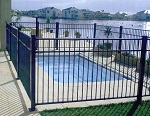 So you have decided to install a pool in your backyard? You know you need to safeguard it, but don’t know where to start. There are several things you need to consider about how you will secure your investment and ensure everyone’s safety. Your best bet is to look at your options before you have to make a decision about pool fencing , so you can make an informed decision.
So you have decided to install a pool in your backyard? You know you need to safeguard it, but don’t know where to start. There are several things you need to consider about how you will secure your investment and ensure everyone’s safety. Your best bet is to look at your options before you have to make a decision about pool fencing , so you can make an informed decision.
Know the Regulations — The first thing you need to do before you install a pool fence is the regulations in your area. There are no federal laws governing pool fences. Those laws are left to the state and local governments. In Arizona, for instance, you must have a fence around your pool, but only if you have a child under the age of six. However, if you live in certain cities in Arizona (including Scottsdale and Glendale), you must have a fence regardless of the age of your children. You also have to consider homeowner’s association rules. Many HOA’s have specific guidelines regarding pool construction and fencing types to maintain a standard through the neighborhood. Be sure to check with your HOA to find out their requirements as well.
Suggested Minimums — The U. S. Consumer Product Safety Commission in conjunction with legal requirements in many states, has put together a list of suggestions for pools to maintain a safe area. They include:
• The fence should be a minimum of 4 feet or higher and should be designed so that children cannot climb it
• The fence should be permanent as temporary or “portable” fencing can be easy to get through
• The fence should have a gate that opens outward and is both self-latching and self-closing
• The fence should be made of a material that is durable and fits with requirements based on your local government and your HOA
Materials and Styles — The most popular materials for a pool safety fence are wood, vinyl, aluminum, mesh and glass. Each material has its own pros and cons concerning durability and appearance. The three most popular types that are:
• Glass panel fencing — These are very trendy right now, especially for West Coast homeowners. These panes of fencing are transparent, so you don’t take away from the beauty of the pool and the surrounding landscaping. They are also very durable since they are made from tempered glass that will not shatter, except under the most extreme of circumstances.
• Mesh pool fencing — This is another popular choice because, although it is portable and can be taken down easily, it is ultimately very sturdy and durable. Just be sure that the material you choose for this type meets or exceeds the strength standards for your locality.
• Vertical bar fencing — This option can be manufactured in a variety of materials, but one of the best is wrought iron. Panels of bars are placed standing straight up to give a feel of a wrought iron gate all around your pool. Just make sure that the bars are spaced four inches (or less) apart so that a child cannot slip through the bars.
All homes with pools should also include rescue equipment like a safety flotation device for emergencies. Homeowners can go the extra mile for security and peace of mind, with additional features such as pool alarms and automatic rigid pool covers. Regardless of what you choose, be sure to pick the type that is right for your home and that meets the requirements of your community.